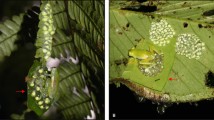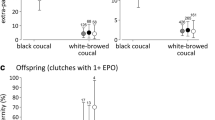Abstract
Communal breeding, where reproducing females share a nest and the care of their pups, occurs in many animal species. According to kin selection theory, alloparental behaviour should occur predominantly among closely related conspecifics. However, familiarity between females, a prerequisite for reciprocal altruism, may also play a role. The aim of our study was to analyse the effect of kinship and familiarity on the occurrence of two types of alloparental care—nursing and the retrieval of pups wandering from the nest—in a communally breeding rodent, the Sinai spiny mice Acomys dimidiatus. In addition, the effects of other factors that may also have an impact on alloparental care were tested; these included age difference between litters, pup age, maternal experience, pup sex ratio, litter size, group age, and mother’s weight. We found that kinship and familiarity had no effect on alloparental care. The nursing of alien pups depended on the maternal reproductive experience measured as the number of weaned litters and also on the age difference between the litters of both females. Less experienced females nursed alien pups more often than experienced ones. With increasing age difference between litters, females preferentially nursed their own pups. Similarly, the retrieval of alien pups was affected by the age disparity between the litters; with increased age difference, the females more readily retrieved their own pups. These results indicate that the occurrence of alloparental care in the Sinai spiny mouse may be more related to misdirected parental care than to kin selection.






Similar content being viewed by others
References
Balshine S, Leach B, Neat F, Reid H, Taborsky M, Werner N (2001) Correlates of group size in cooperatively breeding cichlid fish (Neolamprologus pulcher). Behav Ecol Sociobiol 50:134–140
Bårdsen BJ, Fauchald P, Tveraa T, Langeland K, Nieminen M (2009) Experimental evidence of cost of lactation in a low risk environment for a long-lived mammal. Oikos 118:837–852
Bourke AFG, Heinze J (1994) The ecology of communal breeding: the case of multiple-queen leptothoracine ants. Philos T Roy Soc B 345:359–372
Cavigelli SA, Ragan CM, Barrett CE, Michael KC (2010) Within-litter variance in rat maternal behaviour. Behav Process 84:696–704
Čížková B, Šumbera R, Frynta D (2011) A new member or an intruder: how do Sinai spiny mouse (Acomys dimidiatus) families respond to a male newcomer? Behaviour 148:889–908
Clutton-Brock T (2002) Breeding together: kin selection and mutualism in cooperative vertebrates. Science 296:69–72
Clutton-Brock T, Albon SD, Guiness FE (1989) Fitness cost of gestation and lactation in wild mammals. Nature 337:260–262
Cockburn A (1998) Evolution of helping behaviour in cooperatively breeding birds. Ann Rev Ecol Evol S 29:141–177
Dewey T (2003) Mammals, I–V: rats, mice and relatives V. In: Hutchins M, Kleiman DG, Geist V, McDade MC (eds) Grzimek’s animal life encyclopaedia, 2nd edn. Gale Group, Farmington Hills, pp 281–298
Dieterlen F (1962) Geburt und Geburtshilfe bei der Stachelmaus, Acomys cahirinus. Z Tierpsychol 19:191–222
Dobson FS, Jacquot C, Baudoin C (2000) An experimental test of kin association in the house mouse. Can J Zool 78:1806–1812
Dugatkin AL (1997) Cooperation among animals: an evolutionary perspective. Oxford University Press, New York
Eberle M, Kappeler PM (2006) Family insurance: kin selection and cooperative breeding in a solitary primate (Microcebus murinus). Behav Ecol Sociobiol 60:582–588
Epensperger LA, Hurtado MJ, Valdivia I (2006) Lactating females do not discriminate between their own young and unrelated pups in the communally breeding rodent, Octodon degus. Ethology 112:921–929
Fletcher JA, Zwick M (2006) Unifying the theories of inclusive fitness and reciprocal altruism. Am Nat 168:252–262
Frynta D, Palupčíková K, Bellinvia E, Benda P, Skarlandtová H, Schwarzová L, Modrý D (2010) Phylogenetic relationships within the cahirinus-dimidiatus group of the genus Acomys (Rodentia: Muridae): new mitochondrial lineages from Sahara, Iran and the Arabian Peninsula. Zootaxa 2660:46–56
Frynta D, Fraňková M, Čížková B, Skarlandtová H, Galeštoková K, Průšová K, Šmilauer P, Šumbera R (2011) Social and life history correlates of litter size in captive colonies of precocial spiny mice. Acta Theriol 56:289–295
Gerlach G, Bartmann S (2002) Reproductive skew, costs and benefits of cooperative breeding in female wood mice (Apodemus sylvaticus). Behav Ecol 13:408–418
Hamilton WD (1964) The genetical evolution of social behaviour. J Theor Biol 7:1–52
Hatchwell BJ (2009) The evolution of cooperative breeding in birds: kinship, dispersal and life history. Philos T Roy Soc B 364:3217–3227
Hayes LD (2000) To nest communally or not to nest communally: a review of rodent communal nesting and nursing. Anim Behav 59:677–688
Jannett FJ (1982) Nesting patterns of adult voles, Microtus montanus, in field populations. J Mamm 63:495–498
Jesseau SA, Holmes WG, Lee TM (2008) Mother-offspring recognition in communally nesting degus, Octodon degus. Anim Behav 75:573–582
Koenig WD, Dickinson JL (2004) Ecology and evolution of cooperative breeding in birds. Cambridge University Press, Cambridge
König B (1993) Maternal investment of communally nursing female house mice (Mus musculus domesticus). Behav Process 30:61–74
König B (1994a) Components of lifetime reproductive success in communally and solitarily nursing house mice—a laboratory study. Behav Ecol Sociobiol 34:275–283
König B (1994b) Fitness effects of communal rearing in house mice: the role of relatedness versus familiarity. Anim Behav 48:1449–1457
König B (1997) Cooperative care of young in mammals. Naturwissenschaften 84:95–104
Lacey EA (2004) Sociality reduces individual direct fitness in a communally breeding rodent, the colonial tuco-tuco (Ctenomys sociabilis). Behav Ecol Sociobiol 56:449–457
Lacey A, Wieczorek JR (2004) Kinship in colonial tuco-tucos: evidence from group composition and population structure. Behav Ecol 15:988–996
Lambin X, Krebs CJ (1997) Can changes in female relatedness influence microtine population dynamics? Oikos 61:126–132
Lambin X, Mathers C (1997) Dissipation of kin discrimination in Orkey voles (Microtus arvalis orcadensis): a laboratory study. Ann Zool Fenn 34:23–30
Libhaber N, Eilam D (2004) Parental investment in social voles varies and is relatively independent of litter size. J Mammal 85:748–755
Liu H, Wang DH, Wang ZW (2003) Energy requirements during reproduction in female Brandt’s voles (Microtus brandtii). J Mammal 84:1410–1416
Maniscalco JM, Harris KR, Atkinson S, Parker P (2007) Alloparenting in Steller sea lions (Eumetopias jubatus): correlations with misdirected care and other observations. J Ethol 25:125–131
Manning CJ, Dewsburry DA, Wakeland EK, Potts WK (1995) Communal nesting and communal nursing in mice, Mus musculus domestici. Anim Behav 50:741–751
Mappes T, Ylonen H, Viitala J (1995) Higher reproductive success among kin groups of bank voles (Clethrionomys glareolus). Ecology 76:1276–1282
Marin G, Pilsatro A (1994) Communally breeding dormice, Glis glis, are close kin. Anim Behav 47:1485–1487
Mateo JM, Holmes WG (2004) Cross-fostering as means to study kin recognition. Anim Behav 68:1451–1459
Mennella JA, Blumberg MS, McClintock MK, Moltz H (1990) Inter-litter competition and communal nursing among Norway rats: advantages of birth synchrony. Behav Ecol Sociobiol 27:183–190
Musser GG, Carleton MD (2005) Superfamily Muroidea. Mammal species of the world: a taxonomic and geographic reference, 1st edn. Johns Hopkins University Press, Baltimore
Noren SR (2008) Infant carrying behaviour in dolphins: costly parental care in an aquatic environment. Funct Ecol 22:284–288
Nowak RM (1999) Walker’s mammals of the world, 6th edn. Johns Hopkins University Press, Baltimore
Packer C, Lewis S, Pusey A (1992) A comparative analysis of non-offspring nursing. Anim Behav 43:265–281
Patris B, Baudoin C (2000) A comparative study of parental care between two rodent species: implications for the mating system of the mound-building mouse Mus spicilegus. Behav Process 51:35–43
Peitz B (1981) The oestrous cycle of the spiny mouse (Acomys cahirinus). J Reprod Fertil 61:453–459
Pereira M (2006) Nonselective maternal bonding but pup recognition in the subterranean rodent Ctenomys pearsoni. J Comp Psychol 120:411–415
Pluháček J, Bartošová J, Bartoš L (2011) A case of adoption in captive plains zebra (Equus burchellii). Behav Process 122:127–132
Porter RH (1986) Chemical signals and kin recognition in spiny mice (Acomys cahirinus). Chem Signal 4:397–411
Porter RH (1988) The ontogeny of sibling recognition in rodents: superfamily Muroidea. Behav Genet 18:483–492
Porter RH, Doane HM (1978) Studies of maternal behavior in spiny mice (Acomys cahirinus). Z Tierpsychol 47:225–235
Porter RH, Cavallaro SA, Moore JD (1980) Developmental parameters of mother-offspring interactions in Acomys cahirinus. Z Tierpsychol 53:153–170
Porter RH, Moore JD, White DM (1981) Food sharing by sibling vs non-sibling spiny mice (Acomys cahirinus). Behav Ecol Sociobiol 8:207–212
Porter RH, Tepper VJ, Baumeister AA, Cernoch JM, Matochik JA (1982) Interactions among unfamiliar spiny mouse (Acomys cahirinus) weanlings. Behav Neural Biol 34:190–200
Price E (1992) The costs of infant carrying in captive cotton-top tamarins. Am J Primatol 26:23–33
Price T, Millington S, Grant P (1983) Helping at the nest in Darwin’s finches as misdirected parental care. Auk 100:192–194
Randall JA, Rogovin K, Parker PG, Eimes JA (2005) Flexible social structure of a desert rodent, Rhombomys opimus: philopatry, kinship, and ecological constraints. Behav Ecol 16:961–973
Riedman ML (1982) The evolution of alloparental care and adoption in mammals and birds. Q Rev Biol 57:405–435
Rogowitz GL (1996) Trade-offs in energy allocation during lactation. Am Zool 36:197–204
Roulin A (2002) Why do lactating females nurse alien offspring? A review of hypotheses and empirical evidence. Anim Behav 63:201–208
Russell AF, Hatchwell BJ (2001) Experimental evidence for kin-biased helping in a cooperatively breeding vertebrate. Proc R Soc Lond 268:2169–2174
Rusu AS, Krackow S (2004) Kin-preferential cooperation, dominance-dependent reproductive skew and competition for mates in communally nesting female house mice. Behav Ecol Sociobiol 56:298–305
Rusu AS, König B, Krackow S (2004) Pre-reproductive alliance formation in female wild house mice (Mus domesticus): the effects of familiarity and age disparity. Acta Ethol 6:53–58
Rutte C, Taborsky M (2008) The influence of social experience on cooperative behaviour of rats (Rattus norvegicus): direct vs generalized reciprocity. Behav Ecol Sociobiol 62:499–505
Sayler A, Salmon M (1971) An ethological analysis of communal nursing by the house mouse (Mus musculus). Behaviour 40:62–85
Schradin C, Anzengerger G (2001) Costs of infant carrying in common marmosets, Callithrix jacchus: an experimental analysis. Anim Behav 62:289–295
Scott MP (1998) The ecology and behavior of burying beetles. Annu Rev Entomol 43:595–618
Spencer-Booth Y (1971) The relationships between mammalian young and conspecifics other than mothers and peers: a review. Adv Stud Behav 3:119–194
Strickler SA (2013) Recognition of young in a colonially nesting bird. Ethology 119:130–137
Symonds MRE, Moussalli A (2011) A brief guide to model selection, multimodel inference and model averaging in behavioural ecology using Akaike’s information criterion. Behav Ecol Sociobiol 65:13–21
Trivers RL (1971) The evolution of reciprocal altruism. Q Rev Biol 46:35–57
Volobouev V, Auffray JC, Debat C, Gautun JC, Tranier M (2007) Species delimitation in the Acomys cahirinus-dimidiatus complex (Rodentia, Muridae) inferred from chromosomal and morphological analysis. Biol J Linn Soc 91:203–214
Weidt A, Hoffmann SE, König B (2008) Not only mate choice matters: fitness consequences of social partner choice in female house mice. Anim Behav 75:801–808
Wisenden BD (1999) Alloparental care in fishes. Rev Fish Biol Fish 9:45–70
Wollf JO (1994) Reproductive success of solitarily and communally nesting white-footed mice and deer mice. Behav Ecol 5:206–209
Acknowledgments
We are grateful to Radka Pešková for providing care for our animals. We would also like to thank Simona Poláková and Petr Šmilauer for their help with statistical analyses. We also appreciate the help of Rich Klee, Christopher Steer and William Lee Shelton for the proofreading of this paper.
Author information
Authors and Affiliations
Corresponding author
Ethics declarations
This study was funded by GAJU 39_2007_P-PŘF. The authors declare that they have no conflict of interest. All applicable international, national and/or institutional guidelines for the care and use of animals were followed. The experimental animals suffered no harm, and the experiments were performed in accordance with all Czech laws and implemented all corresponding EU regulations. All procedures performed in the study involving animals were in accordance with the ethical standards of the Animal Ethic Committee of the Faculty of Science, University of South Bohemia, and Ministry of Education, Youth and Sport of the Czech Republic (26300/2007-30). This article does not contain any studies with human participants by any of the authors.
Additional information
Communicated by C. Soulsbury
Rights and permissions
About this article
Cite this article
Tučková, V., Šumbera, R. & Čížková, B. Alloparental behaviour in Sinai spiny mice Acomys dimidiatus: a case of misdirected parental care?. Behav Ecol Sociobiol 70, 437–447 (2016). https://doi.org/10.1007/s00265-016-2065-7
Received:
Revised:
Accepted:
Published:
Issue Date:
DOI: https://doi.org/10.1007/s00265-016-2065-7




